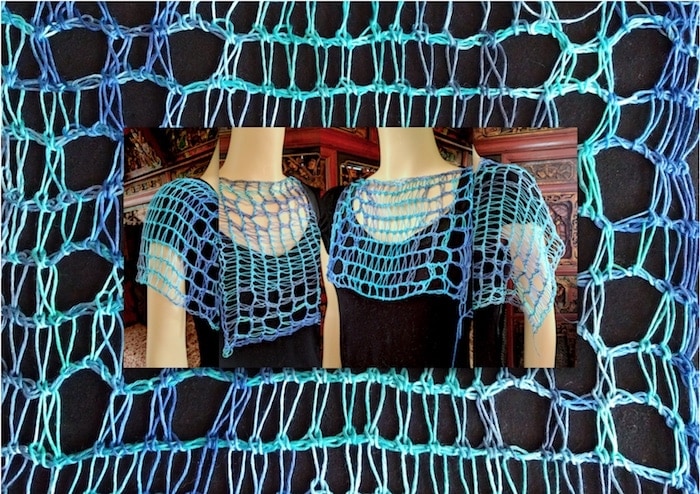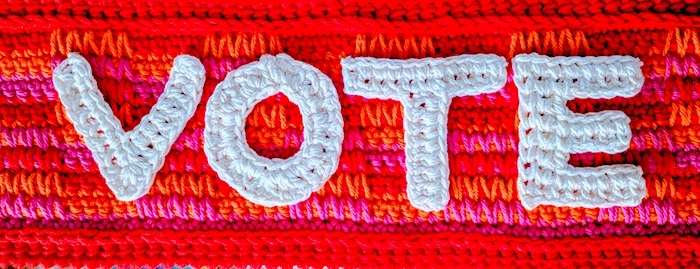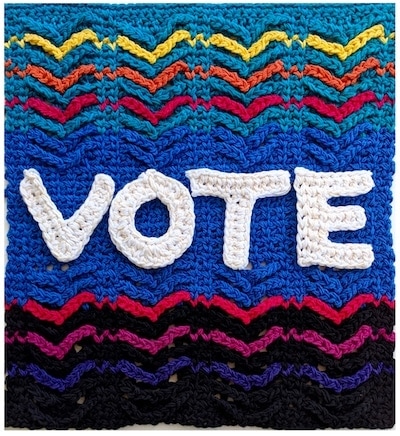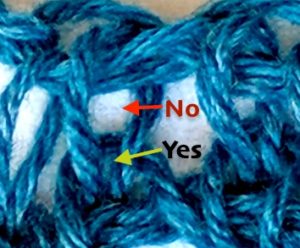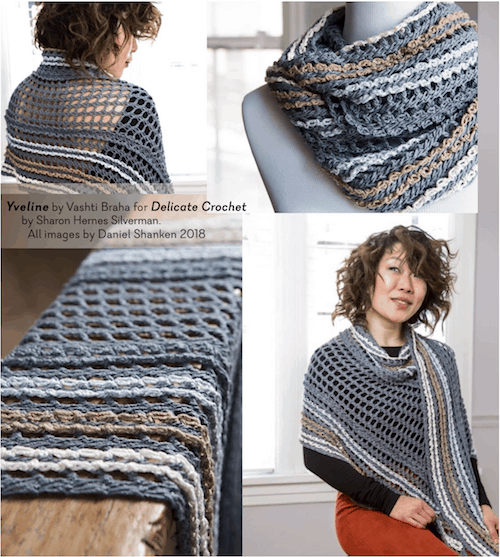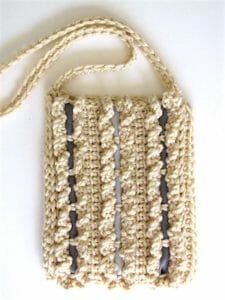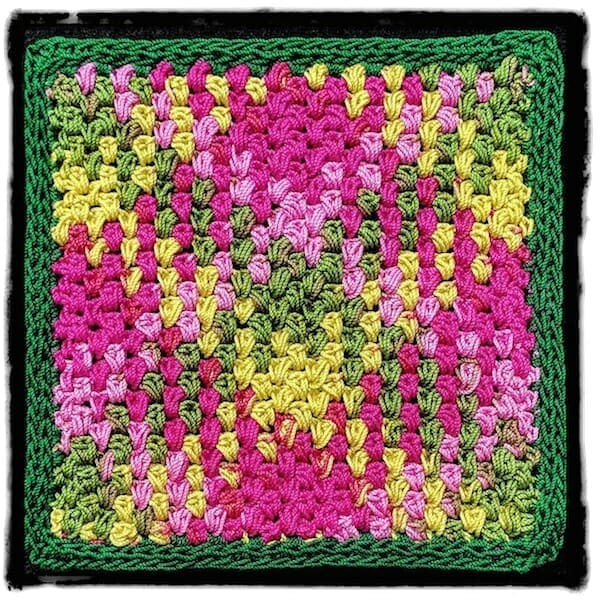This blog post is part of today’s newsletter issue #96. That issue has a storewide 25% off coupon code in it as a thank you to my subscribers. Look for it in your inbox later today. Also check your spam folder because this is a high-volume week for email. (Not a subscriber? It’s not too late.)
The clean, bold holiday template I used for issue #96 limits how I want to write, so here’s the rest of the story. This year I look at my holiday crochet project habits over the years. (By “holidays” I mean from Thanksgiving in the USA to New Years Day.)
Holiday Crochet Project Types
It turns out I look for about eight kinds of holiday crochet projects! Sounds like a lot but they usually overlap. I wonder if you are the same way? I’ve compressed my list into three in no special order.
Feel the Peace of the Season
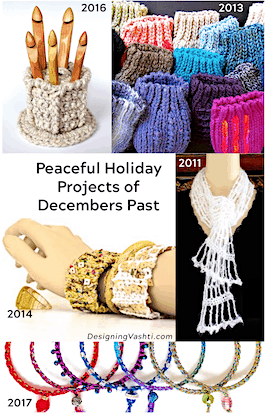
Crochet is my go-to to relax and recharge, and it has been ever since I was nine years old. (When I learned how to do Transcendental Meditation, my first thought was, “This is like crocheting.”)
The crochet that replenishes me during the holidays is an instinctive thing and unique to each year. I loved looking back at these!
Clockwise from top left of image #1:
- Big Hook Bucket of 2016 (I made three). Seeing it daily in my studio makes me happy.
- Luckyslip Mitts of 2013: I just kept making ’em in all kinds of yarns, sizes, and stitch accents.
- Antoinette Sparklescarf of 2011: The one shown is made with the same breathtaking yarn that inspired Starwirbel later. I made about ten and turned some into reusable gift wrapping ribbon.
- Solstice Bangles of 2017. I really needed a lot of gem-like bling last year. Each was a tiny retreat: I got totally immersed for short moments because the materials were tricky, but each bangle was quick to complete.
- Bling Bam Bangles of 2014: Took me by surprise. I wondered what it would be like to crochet Lotus yarn with a strand of sequined thread and I couldn’t stop. Very simple. A mindless, familiar rhythm.
Last-Minute Gift Making
I’m easily inspired by great new gift ideas to crochet, but I typically don’t have a sense of occasion until the last minute. (Fortunately crocheting smaller items is fun. They often become new designs instead of gifts though.) I greatly admire event planners and others who can plan ahead well, like those who have crochet gift lists they work through months ahead.
Last minute gift crocheting puts a burden on a crochet pattern to be easy to understand, and to call for no-fuss materials. It’s sort of like freelance crocheting for magazines in the sense that it’s tight deadline crochet.
If the item is a crowd pleaser, then it’s production crochet territory. Ideally the pattern is easy to memorize for make multiple items from it, efficiently (and still be fun).
Niche Crochet Gifts
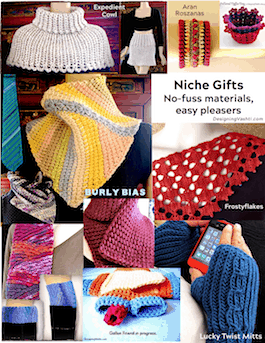
Niche items are about specialized appeal and could be the perfect thing for someone. I focused on some in the newsletter: men, boys, teens, tweens, teachers, and mothers-in-law. These are the patterns shown clockwise from top left of image #2:
- Expedient Cowl: Has trend appeal for teens and 20-somethings, including as a skirt! What makes it fast and easy enough is the super-bulky yarn, big hook size, and simple stitches.
- Aran Rozsana cuff: Folk-boho jewelry trend. A mood boost to crochet with fingering or sport yarns and embroidery flosses because of the colors. Mostly single crochet (UK/AUS: dc).
- Petticoat Cozy: Just a token gift item. It’s the double layer of lace that appeals to people. Same yarns as Aran Rozsana.
- Frostyflakes: A really popular pattern and addictive to crochet! It has special appeal to women over 30. Use any yarn; I even made a bookmark with size 20 thread.
- Gallon Friend: This curio is very niche. Make them for grade school and ESL school teachers, children, and for home cooks. I’ve always wanted to try a keychain size in thread!
- Lucky Twist Mitts: One of the patterns that comes to mind for men. Has sizing for both sexes, same with Luckyslip Mitts.
- Slip Slope: The scarf is a crowd pleaser and Google Trends tells me the boot cuffs are still trending high for younger folks! Also see the Lucky Twist Boot Cuff pattern in Ravelry.
- Burly (center) and Burly Bias: The basic Burly scarf for men and boys, and the niche diagonal Tunisian necktie for the man who has everything. I love making the ice creamy one and like how it settles on my shoulders and frames my face.
Crochet Gifts for Mothers-in-Law
Seems oddly specific, doesn’t it? I’m surprised by the number of times someone has told me they used one of my patterns, or took one of my classes, specifically so that they could make the item for their mother-in-law. (My own mother-in-law wanted a white angora hat to keep her ears warm.) The mother-in-law patterns:
- Satin Pillows Necklace (often for Mother’s Day too.) Add a matching bracelet!
- Starwirbel
- Weightless Wrap Maybe do a scarf size if you’re making it for Christmas.
- Electra Wrap Plan ahead for this one or do a scarf size at this time of year.
- Frostyflakes (listed and pictured above)
Hostess Gifts
Some Decembers I go to so many parties. A pile of small crocheted gifts on hand would be great. Maybe a sack or decoration for a wine bottle, to decorate the lid of fresh-spiced nuts, etc.
Last year I had extra Solstice Bangles to toss onto a wine bottle neck—so festive! And the hostess ends up with new bangles.
Trend-Inspired
I checked on this season’s knitwear trends and this is what I found:
- Creative use of fringe remains a strong fashion trend. My first thought is the Starpath Scarf because at this time of year it’s easy to set it down and remember what you were doing when you get back to it. Also, no ends to weave in, no matter how many colors you use.
- Giant yarns, stitches, and accessories. Burly and the Expedient Cowl in super-bulky yarn (see Image #2 above) are tame compared to what’s on the runway. A Q-Star Coverlet in bulky yarn would be a lavish winter blanket! Or rug/bath mat?
- Asymmetry, and diagonal/multidirectional seams and surface grain. Hello, Burly Bias (see above).
Go Luxe!
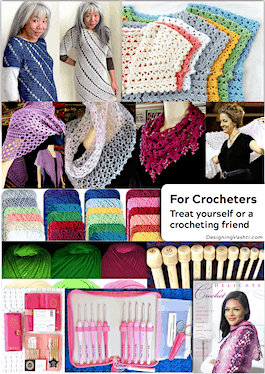
The holidays is when I splurge and reinvest in my craft. I hope you also treat yourself or another crocheter. Beyond shopping and spending, to me it’s about using this time to crochet with my fanciest yarn stash and maybe break in some new crochet hooks.
Other years it has been about bling. This year I’m feeling very angora-luxe. I’ve been hoarding angora yarn for too long.
If someone asked me what they should get from my shop and money was no object for them (or they want to make the most of the coupon code in the newsletter), these come to my mind in no special order:
- Top row, Doris Chan’s DJC patterns (examples: Spirals, Lotus Bolero). And, cones of Lotus to go with them.
- Next row, these patterns of mine as an investment for the particular crochet experiences they provide: Eilanner, Starwirbel, Rosepuff, Weightless.
- Third row, every color of Lotus in Snack ball size (3 Six Packs would be 18 colors). So fun to have on hand.
- Next row, Jelly Yarn (especially glow and glitter colors); Tunisian hooks in every size.
- Bottom, a compact Japanese hook set like Classic 3, Tulip’s deluxe rose Etimo set, and the brand new Delicate Crochet book (in Amazon but Karen McKenna is having a giveaway for it on her blog for the next five days!).
I wish for you the experience I aim to have with my 2018 holiday crochet projects: peace, cheer, inspiration, and warmth inside and out.
